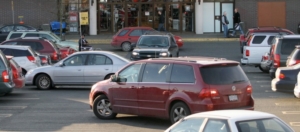Steve Wallace: Readers reflect on making proper turns

If a crash occurs when a driver is backing up from a parking space at a mall, it will almost always be the fault of the backer, Steve Wallace writes.
Year-end is a good time to respond to questions from readers that got missed in the mix.
Alan reminded me that right turns on a solid red traffic light are not mandatory. Left turns in the same circumstance onto a one-way street are in the same category. It should be noted that the obligation is not there in normal traffic, but one will be marked down severely on a driving test if the opportunity is readily available and not taken.
While we are on the subject of a left turn onto a one-way street from a solid red traffic light, Barb wanted to make the point it can be made from a two-way street to a one-way street, as well as a one-way to one-way, which is the only allowance in Manitoba and Saskatchewan.
Harry wanted clarification about backing from a parking space at the mall. If a crash happens, it will always be totally (or in isolated cases, partly) the fault of the backer. He also wanted an explanation for the delay in getting underway from a light change from red to green turn arrow. I can only answer that drivers might want to be extra safe, or perhaps it is best explained by referencing the ghostly geriatric gap.
David wanted to qualify the legality of the left turn over a double solid line on a roadway. This move is legal. It is usually done when entering or leaving a residence, but can be seen at
intersections as well. The police can issue a traffic ticket if there are drivers behind being held up by such a left-over-double solid line configuration. The usual tipping point is if three
vehicles or more are being held up. The courts are less than sympathetic when fewer than three vehicles are affected. The enforcement might be less than consistent from municipal police jurisdictions to RCMP territory.
John wanted everyone to know if it is best to put a standard transmission vehicle in the opposite gear to the hill direction when leaving a vehicle parked. He has seen contrary advice in various publications.
Andy referenced the odd school zone signs at an elementary school. Two 30-km/h zone signs, a block apart, govern the exit to the school zone. Which one counts? The first one the driver encounters when exiting the zone is the release point from the zone. One must still be very careful around schools.
Gail wants to remind all drivers to leave space for cross traffic at side entry points of through roads. Blocking an intersection is not legal.
Mark wants to know why it is necessary for transit drivers to signal left when leaving a bus stop, when they have no intention to leave the curb lane they occupy. He thinks they should just activate the four-way flashers instead. This would make it easier to predict their intention.
Anne wants all drivers to turn from the closest lane to the closest lane on all multi-lane roads. This is good advice. Regardless of legality, it makes sense to reduce the crash potential by doing the predictable.
Dennis wants all motor-vehicle drivers to be aware of the new types of electric bicycles. They can reach higher speeds very quickly, and are able to keep up with motor vehicles on many residential and some city connector roads. It is not always necessary to pass.
Helen is bothered by the simultaneous use of headlights and fog lights. This is an odd situation. Years ago, this practice was a violation. Lately, there seems to be a reluctance by police to charge drivers for doing so.
More on this issue in the new year.
Steve Wallace is the owner of Joan Wallace Driving School on Vancouver Island. He is a former vice-president of the Driving Schools Association of the Americas, a qualified B.C.
teacher and a University of Manitoba graduate.


